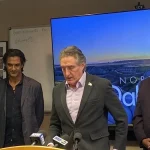The OSU College of Osteopathic Medicine at the Cherokee Nation is expected to improve health care delivery in rural areas of Oklahoma. (Cherokee Nation)
As the popular adage goes, health is wealth. Tribes and indigenous entrepreneurs across Indian Country are taking proactive, sovereign control over the health of their tribal communities and future generations.
In 2018, Native Business Magazine reported on various news item related to native people and the healthcare industry, such as a new facility in Montana named in honor of Elouise Cobell, created to advance training opportunities for Native American nursing and education students.
But topping the list of our highest trending healthcare-related stories for 2018 were these four articles published on NativeBusinessMag.com:
1) Nationally, only 0.2 percent of medical school students are Native American. The OSU College of Osteopathic Medicine at the Cherokee Nation aims to change that.
Coming in 2020, a tribally-affiliated medical center for higher education will open on the Cherokee Nation reservation. The tribe and Oklahoma State University (OSU) inked an historic partnership to bring the OSU College of Osteopathic Medicine at the Cherokee Nation to tribal lands in Tahlequah, Oklahoma. (The other OSU College of Osteopathic Medicine is located in Tulsa, Oklahoma.)
Current plans call for the enrollment of an inaugural class of up to 50 students starting in the fall of 2020. The new medical college will be located in W.W. Hastings Hospital campus.
Enrollment will be open to Native and non-Native students, but the Cherokee Nation hopes many graduates stay local to practice.
“The establishment of the OSU College of Osteopathic Medicine at the Cherokee Nation is the culmination of years of work, and is part of our steadfast commitment to making Cherokee Nation’s health care not only the best in Indian country, but the best in the state of Oklahoma,” said Chief Bill John Baker, Principal Chief of the Cherokee Nation. “Recruiting primary care physicians to practice within the Cherokee Nation’s 14-county jurisdiction remains a constant struggle. We admire and support OSU Center for Health Sciences’ efforts to populate rural Oklahoma with doctors from rural Oklahoma. That mission will create healthier families and communities in northeast Oklahoma and improve the lives of Cherokees for the next seven generations.”
Read the full article: Coming in 2020: The First-Ever Tribally Affiliated Medical School in America

2) Yoga instructor and entrepreneur Haley Laughter, Navajo, leads invigorating movement breaks at conferences across Indian Country.
Haley Laughter’s yoga studio is Mother Nature and conference venues. “Giving Natives access to yoga means that I have to be mobile. I’m bringing yoga to our people,” says Laughter (Navajo), founder and CEO of Hozho Total Wellness.
Laughter launched Hozho Total Wellness in 2015 to help Natives release stress and historical trauma through yoga, a practice intended to heal the mind, body and spirit. Today, she travels to host energizing yoga classes, as well as brief breaks of stretching and movement, at business conferences across Indian Country.
Read the full article: Flexible Biz: Hozho Total Wellness Brings Yoga to Conferences

3) Two decades after the Cook Inlet Region Inc. (CIRI) assumed total control of its healthcare system, the results are in: the Nuka System of Care has not only survived, but has become a model and global leader in the management and provision of health services.
“Alaska Native people have assumed the entire role of healthcare delivery from the federal government,” said Dr. Katherine Gottlieb, president and CEO of Southcentral Foundation.
Gottlieb, who is a tribal member of the village of Old Harbor, a tribal member and elected tribal council member for Seldovia Village Tribe, and an honorary member of the Native Village of Eklutna, says that the overhaul in healthcare services for Alaska Natives was based on simple questions that no one had ever bothered to ask: What do the people want? What would improve their lives?
Under this system, according to the SCF website, the primary focus is relationship building and shared decision-making between the patient and his or her primary care team—with the goal of attaining good health, as opposed to treating illness. The Nuka system provides access to over 80 programs, including medical, dental, behavioral, traditional and healthcare support services.
Today, Nuka serves nearly 65,000 Alaska Native and American Indian people living in Anchorage, Matanuska-Susitna Valley and 55 rural villages in the Anchorage Service Unit, covering almost 110,000 square miles in Southcentral Alaska.
Read the full article: Southcentral Delivers ‘Nuka System of Care’ & Empowers Patients as Customer-Owners

4) Navajo Nicolle Gonzales has conceived a plan for an indigenous-operated midwifery center.
The cost of childbirth in the U.S. is the highest in the world. Few rural indigenous women can afford conception to post-partum care. This has contributed to a native infant mortality rate of 8.3 percent overall, second only to Non-Hispanic Black Women.
Navajo Nicolle Gonzaels is changing this. She has set her sights on forging the first center of midwifery in the United States, hopefully on tribal land. Originally scoped for the Pojoaque Pueblo, she is now seeking a location within 30 minutes’ drive of Santa Fe, New Mexico. She’s also working to secure $7 million in funding to construct the facility.
While birth centers are not a new business model, she and her corporate donors are optimistic that this model will allow Native women — and their children — who only have Medicaid to pay for such services, and to profit physically and emotionally from such a clinic.
Read the full article: Navajo Nicolle Gonzales to Create First Midwifery Center in U.S.







